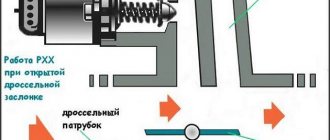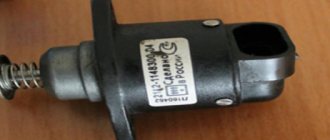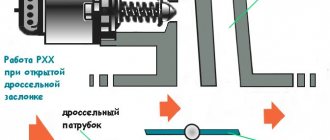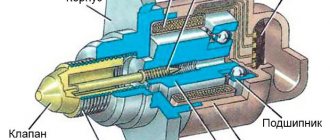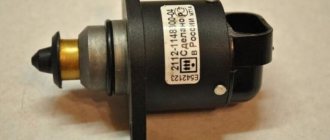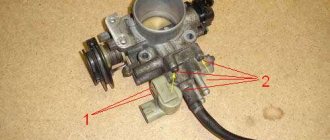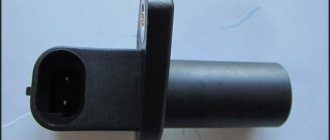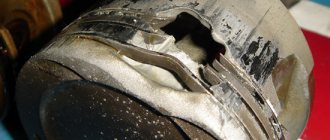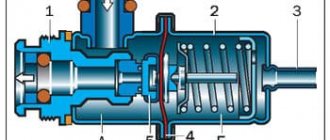Device role
On injection engines that are installed on the VAZ 2110, the XX regulator serves to control the stable operation of the power unit. It is unlikely that you will be pleasantly surprised by a situation in which the idle speed starts to fluctuate, and every now and then the car will stall.
Some people do not know about another very important role of the idle speed sensor - warming up the power unit in case of low air temperature.
It is generally accepted that if there is an injector, there is no need to warm up the engine. The opinion is wrong. Do not overstress the engine, but first let it run for a while without increased speed. This will have a positive effect on the reliability and service life of the motor. .
Location
Externally, the IAC looks quite simple. It looks like a small electric motor. Its design includes three parts:
- Stepper motor;
- Spring;
- A rod with a needle at the end.
And the desired regulator is located near the mechanism that is responsible for changing the position of the throttle valve. There is no complex fastening system. To dismantle you just need to remove the mounting bolts.
How does he work
The function of the IAC is to regulate the amount of fuel supplied. He may indicate the need to increase or decrease the quantity. An important nuance is that the sensor performs its functions directly when the idle speed is turned on.
The actual action of increasing or decreasing occurs due to the extension or retraction of the needle at the end of the rod. The needle is responsible for closing or opening the special channel to the required extent.
Learning to distinguish a fake from an original
Today, many people complain about the abundance of counterfeit products on the auto parts market.
If we talk specifically about the XX regulator for the VAZ 2110, then there are several key signs by which a fake can be distinguished from the original. Be guided by these data so as not to accidentally install a device of dubious quality and origin on your car.
Fake and original
- On fakes, the black body made of metal is 1 millimeter shorter than the real part.
- In the case of the fake, the three white rivets on the case have no heads. They must be present in the original. And the diameter of the caps is 3 millimeters.
- On fakes, the spring is made in white and has more frequent winding. In the original, the coiling is less frequent, and the spring itself is black.
- Pay attention to the rubber ring of the regulator. On fakes it is black and thin, but in the case of a real part, a reddish tint is noticeable. Plus the thickness is greater.
- Take a closer look at the tip. In fakes it is darker compared to the original spare part.
- There are no markings on the counterfeit packaging; the boxes are noticeably different in appearance.
- The original yellow sticker located on the case must have an outer frame. Manufacturers of counterfeits apparently forgot about it.
As you can see, recognizing a fake is not difficult. You just need to be more attentive to details.
The difference is in the boxes
This is interesting: How to replace front brake discs on a Grant
Step-by-step replacement procedure
The replacement procedure is carried out in almost the same way as cleaning the device, but there are certain nuances:
- The battery is disconnected to prevent a short in the wiring.
- The plug with the electrical circuit is disconnected from the control device. If the car is equipped with an injection power unit, then to disconnect the connector you need to press on the plastic fastener.
- The bolts are unscrewed. As when cleaning, first unscrew the left fastener, and then the right one. The failed regulatory device is being dismantled.
- The surface on which the sealing element is mounted is also cleaned. The latter is checked for defects - abrasions, cracks, etc. If they are present, the sealing gum is replaced with a new one. Before installation, the seal is treated with engine fluid, after which it is mounted on the throttle seat.
- The controller is installed, a connector with wires for its power supply is connected. A wire is connected to the battery.
- After installation, a calibration procedure is performed. The microprocessor module must perform this independently; an electronic relay is used for this. To calibrate the new sensor, the ignition is turned on for a few minutes and then turned off. If the actions performed helped and the speed no longer floats, but remains at the same level, then the replacement procedure can be considered complete.
What do you need to know when replacing the IAC?
To change and install a controller that allows you to regulate idle speed, you need to pay attention to the position of the rod. It must not be allowed to be pushed forward too much. This can happen if the device is connected to the block and the ignition is activated before installation. It is not allowed to push the rod in by hand.
If the valve is installed with the needle extended and the retaining screws are tightened, damage to the unit may occur due to shearing of the worm gear. It is impossible to repair such a sensor. Depending on the vehicle model, after installing a new regulator, it may need to be calibrated. In some cars, this procedure is carried out using special equipment or a stand.
On VAZ cars, calibration is performed as follows:
- A terminal is connected to the negative output of the battery.
- The key is turned in the lock to turn on the ignition for ten seconds. There is no need to start the power unit.
- The ignition is turned off.
Learning to distinguish a fake from an original
Today, many people complain about the abundance of counterfeit products on the auto parts market.
If we talk specifically about the XX regulator for the VAZ 2110, then there are several key signs by which a fake can be distinguished from the original. Be guided by these data so as not to accidentally install a device of dubious quality and origin on your car.
Fake and original
- On fakes, the black body made of metal is 1 millimeter shorter than the real part.
- In the case of the fake, the three white rivets on the case have no heads. They must be present in the original. And the diameter of the caps is 3 millimeters.
- On fakes, the spring is made in white and has more frequent winding. In the original, the coiling is less frequent, and the spring itself is black.
- Pay attention to the rubber ring of the regulator. On fakes it is black and thin, but in the case of a real part, a reddish tint is noticeable. Plus the thickness is greater.
- Take a closer look at the tip. In fakes it is darker compared to the original spare part.
- There are no markings on the counterfeit packaging; the boxes are noticeably different in appearance.
- The original yellow sticker located on the case must have an outer frame. Manufacturers of counterfeits apparently forgot about it.
As you can see, recognizing a fake is not difficult. You just need to be more attentive to details.
The difference is in the boxes
Main symptoms of a malfunction
The following may indicate that the sensor is not working correctly:
- Poor engine starting even with the gas pedal depressed.
- Floating idle speed.
- When the transmission is in neutral, the engine stalls.
- When the engine is warm, its speed does not increase.
- When you turn on the stove, light or radio, the engine speed begins to drop.
Experts say that when the situations described above occur, this may not always be the reason that the sensor has broken down . This may be due to spark plugs, filters or fuel quality. All of them must be checked first.
Sensor check
Wiring diagram for idle speed sensor.
- Initially, you need to find a block with wires that supply voltage to the sensor. To do this, you need to unscrew the throttle assembly and move it down.
- Then use a voltmeter to check whether voltage is supplied to the sensor.
- If the device shows 12V, then this will indicate that there is no charging on the battery; when the device does not show anything, then this indicates that the problem must be looked for in the network, since no current is flowing to the sensor.
- If the readings are above 12V, you will need to check the mains voltage regulator.
The check can also be done in another way . To do this, you need to remove the sensor and start the engine, periodically pressing the gas pedal. The needle should float.
» data-lazy-type=»iframe» src=»data:image/gif;base64,R0lGODlhAQABAIAAAAAAAP///yH5BAEAAAAALAAAAAABAAEAAAIBRAA7″>
Cleaning
To clean the sensor, dip its rod in carburetor cleaner for a few minutes.
Sometimes you may simply need to clean the sensor itself if the needle does not float and voltage is applied to the sensor. If cleaning does not help, the unit will need to be replaced.
Symptoms of a problem
The VAZ-2110 idle speed control is a structurally simple mechanism consisting of a stepper electric motor and a spring-loaded needle, the displacement of which leads to a change in the cross-section of the channel. But despite the simplicity of the design, this part often breaks. Symptoms of a broken XX regulator:
- Unstable “floating” crankshaft speed during idle operation;
- Inconsistency of speed with the normal indicator (800-850 rpm);
- Spontaneous stopping of the power plant when releasing the gas pedal;
- No increased speed when starting a “cold” engine (“warm-up” mode);
- Drawdown in speed after creating a load on the on-board network;
It is noteworthy that such symptoms are also caused by a malfunction of the damper position sensor (DPS). But it is not difficult to recognize which sensor is faulty.
The XX regulator is an actuator, and it has no “feedback” from the ECU. Therefore, this sensor does not fall under self-diagnosis. As a result, regulator failure occurs only in the engine. As for the TPS, this element is checked by the system, and if it malfunctions, the “Check engine” will light up.
General concepts
One of the most common troubles that prevents you from fully driving a car is the idle speed sensor of the VAZ 2110 and modifications. Although this device is called a sensor among drivers, it will still be correctly called the idle speed controller, abbreviated as IAC, because all automobile sensors are measuring equipment, and this product serves to automatically stabilize and maintain idle speed by supplying air to the engine VAZ 2110 with the throttle valve fully closed.
IAC is an important component of the engine and plays a significant role in the stable and uninterrupted operation of any VAZ vehicle.
Idle speed control
The VAZ 2110 idle speed sensor (abbreviated DXX) is an actuator, simply a valve consisting of an electric motor, a spring, and a rod on which a shut-off needle is installed (you can see it in the photo). It is through which the volume of air is dosed. That is, when the throttle of a VAZ 2110, 2112 is completely closed, and the controller determines that the idle speed needs to be increased, the IAC generates a command to change the position of the needle. It moves, partially or completely opening the intake port, through which air bypasses the throttle and then mixes with fuel. As a result, the engine does not stall.
Signs of IAC malfunction
Unfortunately, the 2110 VAZ DXX is not equipped with a self-diagnosis system, so the “CHECK ENGINE” light signal will not indicate a malfunction. Loss of performance on the VAZ 2110, 2112 is determined by the following main features:
- the engine “stalls”, for no apparent reason, at idle;
- idle speed “floats”;
- when a “cold” VAZ 2110, 2112 engine is started, there is no increased speed at all;
- The engine stalls, namely, after turning off the gear while driving.
The symptoms completely coincide with the failure of the VAZ 2110 TPS, but in the case of this sensor the “CHECK ENGINE” indicator will light up.
A little theory
A sensor is an element that belongs to the category of measuring instruments. Basically, such a node is used to analyze, process and convert incoming information with subsequent output to a display board.
Among car owners, the idle speed sensor is called the abbreviation IAC. This is one of the most important parts in the internal combustion engine, which is responsible for the stable operation of the vehicle.
This regulator is an actuator, and it is not easy to identify problems with its operation. All this is due to the fact that VAZ cars do not have self-diagnosis. For example, if the IAC breaks down, the “check engine” error will not appear.
Causes of failure. Node check
The reasons for the malfunction of the XX regulator are breaks in the electrical winding. engine and needle jamming due to dirt or corrosion. But the sensor is not always the “culprit” for missing idle speed. Therefore, before removing and checking the sensor, check its power supply circuit.
For all checks you will need a multimeter. The power circuit is checked with a device set to “voltmeter” mode. Diagnostics is simple - we disconnect the block with wires from the regulator, connect the “negative” probe of the multimeter to ground, and the positive one to the terminals marked with the letters “A” and “D”. With the ignition on, we take measurements. If the circuit is working properly, the readings should correspond to the rated voltage of the circuit. If there is no voltage, you should check the computer and relays responsible for powering the sensor.
To make it easier to check the sensor itself, remove it from the car. To do this, you only need a screwdriver. To remove a part you need:
- Disconnect the on-board network (remove the terminal from the battery).
- Find the regulator (installed on the throttle assembly).
- Disconnect the wiring (after operating the lock).
- Unscrew the two fastening screws;
- Remove the regulator.
The element is checked with the same multimeter, but switched to “ohmmeter” mode. We first connect the probes to terminals “A” and “B”, and then to “C” and “D”. With this measurement, the readings are 50-55 Ohms. Then we connect the probes to terminals “A” and “C”, and then to “B” and “D”. During this test, the ohmmeter shows infinity.
If the readings are correct, there is no break inside the sensor, and its incorrect operation is due to the needle getting jammed.
There is an alternative verification method that does not require the use of measuring instruments. This check is simple:
- Remove the sensor from the car.
- We connect the block with wires back to it.
- We power the on-board network (connect the battery).
- Holding the regulator in your hand, place your finger on it.
- We ask someone to turn on the ignition.
If the element is working properly, when the ignition is turned on, the needle will move, which will be clearly felt by your finger. Needle jamming can be eliminated by washing. For these purposes, use WD-40 or carburetor cleaning aerosol. We use these products to treat the needle and spring. Next, we dry the sensor and check its functionality.
How to remove IAC
If signs of malfunction characteristic of the IAC are detected, then it will need to be removed (first for inspection). On the VAZ 2110, this sensor, which is small in size (easily fits in the palm of your hand), is located in a seat on the throttle body (can be seen in the photo).
Removing the idle air control
If necessary, its dismantling is quite easy - it is secured with only two screws. In extremely rare cases, it is necessary to remove the entire VAZ 2110 throttle assembly.
Dismantling is carried out in the following sequence:
- The VAZ 2110 is placed on the handbrake;
- The negative terminal of the battery is disconnected;
- The wiring harness connected to the IAC is disconnected;
- Be sure to clean the connection between the sensor and the throttle body to prevent dirt and rust from getting into the hole;
- Unscrew the fastening screws holding the idle speed sensor of the VAZ 2110.
What could be the sensor malfunctions?
Failures in the functioning of the regulator cause a large number of problems for the car owner. Accordingly, ignoring the problem for a long time can provoke an accident. Therefore, you should not neglect your own safety and it is advisable to identify the malfunction in the early stages.
Signals of a faulty regulator:
- The engine speed constantly fluctuates. You may notice a sudden increase/decrease in this indicator.
- When the engine is cold started, there is no increase in speed.
- When you turn on additional electrical appliances (headlights, stove, etc.), the idle speed decreases noticeably.
- The internal combustion engine stops at idle and when the gear is engaged.
In practice, there are other signs of IAC malfunctions, but in order not to make a mistake and not confuse a sensor malfunction with other failures, it is important to know how the unit in question is checked.
Meaning
The sensor, also known as the idle speed regulator on the VAZ injector, is designed to monitor the stability of the engine. Besides the fact that no one will be happy if the engine floats when the idle speed is turned on, or even stalls, there is another reason why this regulator should work without failures.
This is the need to warm up the engine in cold weather. Although it is generally accepted that if an injector is installed on a car, then the engine does not need to warm up, this is a false opinion, and it is better not to “rip” the engine, but first let it run a little without increasing the speed.
How to check the idle speed sensor of a VAZ. Idle speed and IAC!
Today I will tell you how to check the idle air sensor; by the way, it is correct to call it not the sensor, but the idle air regulator. Due to the fact that this device regulates engine idle speed, and does not read any indicators. Let's look at the breakdown of this sensor and what can be done about it using the example of a VAZ 2110 car, but the IAC is not much different in other cars. I forgot to say IAC is the Idle Air Controller in abbreviation. I myself often call it a sensor, so if later in the article you come across the words regulator or sensor, then don’t be too indignant.
Differences between a fake and an original
Unfortunately, today you can find a lot of counterfeit products on the automobile market. You can distinguish an original from a fake by a number of criteria.
Counterfeit has the following characteristic features:
- the black metal case is exactly 1 mm shorter;
- There are three white rivets on the body. They don't have hats. Unlike counterfeits, the original has them;
- the counterfeit has a white spring, while the original has a black spring;
- the color of the regulator ring on the fake is black, but in the original it has a reddish tint;
- the counterfeit tip has darker shades compared to the original;
- fakes and originals have external differences in the design of the boxes;
- in the original the yellow sticker is framed. Whoever is counterfeiting this part has overlooked this.
If you are extremely careful, recognizing a fake is not difficult.
This is interesting: What kind of drilling is on Mazda 6
How to check and replace the idle air control on a VAZ 2110
On any injection engine there is increased sensitivity to how the electronics and sensors operate.
A component fails, which, at first glance, is of little importance and the engine immediately disrupts its operation: a drop in power is observed, and fuel consumption increases significantly. One of such elements on the VAZ 2110 is the idle air control.
Unfortunately, such a problem occurs much more often than we would like, and almost every car enthusiast can encounter it in his or her practice. In this regard, the question arises about how to check the idle air control on a VAZ 2110 injector?
What role does this sensor play?
It is a kind of regulator that controls the work performed by the power unit. No one will like it if the revs openly float when idling, and the car itself simply stalls. But not everyone also knows that when the outside air temperature drops, it warms up the power unit.
Some people believe that since there is an injector, there is no need to warm up the engine. This statement is not true. Do not overstress the engine. Let it run a little first without over-revving. At the same time, of course, the engine will serve its owner much longer.
Upon external examination, there is nothing remarkable about the sensor.
It consists of three elements:
- Electric motor stepper.
- Spring.
- A rod with a needle located at its end.
In terms of its external outline, it looks like a small electric motor. Many people ask the question: where is the idle speed control of the VAZ 2110? It can be found near the mechanism that is responsible for how the throttle valve changes its position. This is not to say that fixing it is difficult. It's easy to dismantle. To do this, simply unscrew the mounting bolts.
Differences between a fake and an original
Unfortunately, today you can find a lot of counterfeit products on the automobile market. You can distinguish an original from a fake by a number of criteria.
Counterfeit has the following characteristic features:
- the black metal case is exactly 1 mm shorter;
- There are three white rivets on the body. They don't have hats. Unlike counterfeits, the original has them;
- the counterfeit has a white spring, while the original has a black spring;
- the color of the regulator ring on the fake is black, but in the original it has a reddish tint;
- the counterfeit tip has darker shades compared to the original;
- fakes and originals have external differences in the design of the boxes;
- in the original the yellow sticker is framed. Whoever is counterfeiting this part has overlooked this.
If you are extremely careful, recognizing a fake is not difficult.
Choosing a replacement regulator
On the VAZ-2110 with both 8-valve and 16-valve injection engines, a sensor with catalog number 2112-1148300 is used. Additionally, at the end of the marking there is a prefix consisting of two numbers, for example, 01, 02, 03, 04. This index indicates the manufacturer of the regulator (01 and 03 - “Pegasus”, 02 and 04 - KZTA). When choosing a replacement regulator, pay attention to two nuances - the seal and the height of the needle protrusion above the body. Factory spare parts use a red seal, while counterfeits use a black rubber element. The height of the needle protrusion above the body is 23 mm.
Before installing a new regulator, it is recommended to coat the sealing ring with a thin layer of engine oil to ensure a tight fit of the part in the seat and eliminate the possibility of air leaks.
Video: Review of VAZ idle speed controllers
Idle speed sensor for VAZ-2110
Idle speed regulator.
First, let's decide on the catalog number and price of the unit. An idle speed sensor with the original catalog number 2112-1148300 . Its price for 2021 is about 500-550 rubles, depending on the greed of the seller.
By the way, exactly the same regulator is installed on all Priora and Kalina, Tavria, Nanos and Sens.
Be careful not to confuse the sensor we need from below.
Design, purpose and principle of operation of the sensor
IAC (idle air control) or IAC (idle air sensor) is a simple valve or actuator in design. Designed to control air flow when the throttle valve is locked. The control procedure is carried out in accordance with commands received from the microprocessor motor control module.
Russian car enthusiasts believe that the presence of an injector in a car allows it not to warm up the internal combustion engine, but this is not true. Do not overstress the power unit. When starting the internal combustion engine, it must run for a certain time without high speeds. The injector itself regulates idle speed, and the sensor is used to ensure stable speed when a load appears on the internal combustion engine. Both 8- and 16-valve engines use identical idle air controllers.
The device itself, presented in the form of a small-sized electrical unit, includes the following elements:
- spring element;
- electric stepper motor;
- a rod equipped with a needle at the end.
The presence of a working sensor makes it possible to correctly adjust the volume of fuel supplied to the combustion chambers. The volume of fuel can be less or more; we are talking about the supply of gasoline when driving at idle speed. The procedure for adjusting the fuel is carried out by pulling out or retracting the needle of the device, designed to shut off the gasoline supply channel.
Scheme of operation of the IAC on the “ten”
Where is the idle speed sensor located in a car?
The control device is mounted in the engine compartment. The sensor is installed next to the unit designed to control the dampers. The device is connected to this unit using special fixing screws.
The idle speed of the VAZ 2110 is floating, diagnostics and replacement of the IAC
Many people underestimate the importance of sensors or idle air control. But in fact, the speed stability depends on the correct operation of the IAC. It also prevents the car from stalling when the gearshift lever is in an intermediate position.
In this material we will talk about the meaning, device, and signs of malfunction of this device. We’ll also tell you how you can easily replace the IAC with your own hands.
Appearance of the device
Device role
On injection engines that are installed on the VAZ 2110, the XX regulator serves to control the stable operation of the power unit. It is unlikely that you will be pleasantly surprised by a situation in which the idle speed starts to fluctuate, and every now and then the car will stall.
Some people do not know about another very important role of the idle speed sensor - warming up the power unit in case of low air temperature.
It is generally accepted that if there is an injector, there is no need to warm up the engine. The opinion is wrong. Do not overstress the engine, but first let it run for a while without increased speed. This will have a positive effect on the reliability and service life of the motor. .
Location
Externally, the IAC looks quite simple. It looks like a small electric motor. Its design includes three parts:
- Stepper motor;
- Spring;
- A rod with a needle at the end.
And the desired regulator is located near the mechanism that is responsible for changing the position of the throttle valve. There is no complex fastening system. To dismantle you just need to remove the mounting bolts.
How does he work
The function of the IAC is to regulate the amount of fuel supplied. He may indicate the need to increase or decrease the quantity. An important nuance is that the sensor performs its functions directly when the idle speed is turned on.
We recommend: We replace antifreeze in Kia Spectra
The actual action of increasing or decreasing occurs due to the extension or retraction of the needle at the end of the rod. The needle is responsible for closing or opening the special channel to the required extent.
Learning to distinguish a fake from an original
Today, many people complain about the abundance of counterfeit products on the auto parts market.
If we talk specifically about the XX regulator for the VAZ 2110, then there are several key signs by which a fake can be distinguished from the original. Be guided by these data so as not to accidentally install a device of dubious quality and origin on your car.
Fake and original
- On fakes, the black body made of metal is 1 millimeter shorter than the real part.
- In the case of the fake, the three white rivets on the case have no heads. They must be present in the original. And the diameter of the caps is 3 millimeters.
- On fakes, the spring is made in white and has more frequent winding. In the original, the coiling is less frequent, and the spring itself is black.
- Pay attention to the rubber ring of the regulator. On fakes it is black and thin, but in the case of a real part, a reddish tint is noticeable. Plus the thickness is greater.
- Take a closer look at the tip. In fakes it is darker compared to the original spare part.
- There are no markings on the counterfeit packaging; the boxes are noticeably different in appearance.
- The original yellow sticker located on the case must have an outer frame. Manufacturers of counterfeits apparently forgot about it.
As you can see, recognizing a fake is not difficult. You just need to be more attentive to details.
The difference is in the boxes
Signs of breakdown
Based on certain signs, it can be determined that the IAC is out of order and needs to be repaired or completely replaced with a new device.
These signs include:
- Floating idle speed;
- Problems with starting the engine; it starts with difficulty even with the gas pedal pressed;
- It is not possible to increase the speed even when the engine has warmed up sufficiently;
- The engine suddenly begins to stall when shifting into neutral;
- The speed decreases when you turn on energy-consuming devices - stove, air conditioner, audio system, headlights, etc.
But replacing the regulator is not always the right decision. In some cases, removing the old sensor and installing a new device in its place will not bring any results. And all because the culprits of the malfunction may be other elements, such as spark plugs or a fuel filter.
Functionality check
If the engine stalls, the speed fluctuates, or turns out to be high, you must definitely check whether the IAC is working.
To check, you will first need to dismantle the fastenings of the throttle assembly, and then carefully move it literally 10 millimeters.
You will need a voltmeter with which you can check whether there is voltage going to the sensor and what its indicators are. In advance, connect the negative terminal from the battery to ground, and connect the voltmeter to the terminals marked with the letters A and D. Next, check the table.
How IAC works, tasks
Functions, operating algorithm of idle air valves:
- The functional task is the dosage of air supply. When the intake damper is fully open, and the electronics (ECU) detects the need to force idle speed, the IAC changes the location of its valve in the inlet opening in the shape of a thick needle or a long cone.
- This way the volume of incoming air is regulated. Moving, the rod creates the desired gap.
- A path with the required width is created for the air to bypass the throttle and then mix with the fuel.
- The result is that the engine does not stall.
In more detail, the work of the IAC looks like this. If the engine starts in cold weather, the ECU activates the valve to open the intake port, simultaneously supplying a larger volume of fuel for combustion. The revolutions increase, the heating of the internal combustion engine is accelerated. When the operating t° for the auto power plant is reached, the IAC stepper motor moves the closing cone forward. The air flow is reduced, the intensity of the stroke drops.
The VAZ 2112 idle speed sensor stabilizes it and levels it out, preventing jamming by dosing air when the intake valve is closed.
How does IAC work?
The functional unit regulates the volume of air supplied to the engine when the throttle valve is closed. This is necessary to ensure automated control of engine speed at idle.
The sensor is also involved in the process of warming up the internal combustion engine to operating temperature in cold weather. IAC operating range is from -40 to 130 degrees.
When the ignition in the car is turned on, the rod on the regulator extends all the way and rests against the calibration point of the throttle pipe. The IAC counts the steps and the valve returns.
When the motor is on, increasing/decreasing steps changes the amount of passing air masses. The required amount of air mass is supplied to the engine, which will ensure normal operation at idle speed.
The IAC on the VAZ-2110 is small in size and consists of three units:
- Stepper motor.
- Springs and rod.
- The needle is cone-shaped.
The device is secured to the throttle body using two threaded screws.
Replacement Guide
If problems are detected, the DXX must be changed.
If you don’t know how to replace the idle speed sensor on a VAZ 2110, then there’s nothing complicated about it:
- First, disconnect the battery, after which you can disconnect the power cord from the device. If we are talking about an injector, then to disconnect the block you only need to press the corresponding latch.
- After this, you need to unscrew the left and then the right mounting bolt. The sensor itself must be dismantled after these steps. The regulator being replaced must be removed, and then the rubber seal of the new device must be treated with motor fluid. It is better not to use an old seal, especially if it shows signs of damage or cracks. The controller installation area must be thoroughly wiped, after which the device can be installed and the connector with wires can be reconnected.
- Next, turn on the ignition for a few minutes, after which it will need to be turned off. This completes the replacement procedure, as you can see, there is nothing complicated about it.
Removing the device from the engine
How to check the idle speed sensor yourself at home?
The idle speed sensor is quite simple and you can diagnose it yourself at home, without going to a service station. This will save your money and time. There is nothing complicated in diagnosing this device; I will describe it in detail and tell you what needs to be done, even if you have minimal knowledge and experience, you can easily handle it.
Checking the electrical circuit of the idle speed sensor
Once the location of the sensor has been located, you need to make sure that electric current is supplied to it. To do this, we take a multimeter and set it to measure DC current and two thinner wires that need to be connected in turn, first to pins 1 and 2, then 3 and 4, and measure the voltage.
Checking the idle air control circuit.
When checking the integrity of the wires, the car's ignition must be turned on (the car does not need to be started)
, and the multimeter should show 12 Volts.
If there is no voltage, then there is a wire break or other failure somewhere. If there is voltage, go to the second step and check the idle speed sensor itself. 11.2 indicates that the current is approaching the sensor
Replacement procedure
Replacement is carried out in the following order:
- We de-energize the on-board system by removing the negative terminal, which is located on the battery;
- Disconnect the block from the sensor. For a VAZ injector this happens by pressing a plastic latch;
- We unscrew two screws, and it is recommended to first unscrew the left fastener, then the right one;
- Now the regulator has been removed and there is no problem in replacing it with a new one;
- Before installation, it is advisable to spread oil on the sealing ring. See if there are even the slightest cracks on the ring, in which case it needs to be replaced;
- There is also no difficulty in the calibration procedure; the electronic relay will do everything. You just need to turn on the ignition for a few minutes and then turn it off. After this, the speed usually no longer fluctuates, and the car works without failures.
(11 votes, average: 3.3 out of 5)
How to repair the idle speed sensor yourself?
The procedure for repairing the device consists of dismantling the regulator and cleaning it. To perform this task, you will need WD-40 or carburetor engine cleaner.
Sequence of actions when repairing the sensor
Algorithm of actions for repairs:
- The VAZ 2110 is placed on a flat surface to prevent arbitrary rolling. The parking brake lever is raised.
- The engine compartment of the car opens. The negative clamp is disconnected from the battery terminal, this will prevent a short circuit when performing the task.
- The regulator itself is located on the throttle body. You need to disconnect the plastic latch from it and disconnect the connector with the wiring.
- Use WD-40 or carburetor cleaner. With the help of liquid, all channels are cleaned; for this, the jet is directed directly into them. You can use a cotton swab treated with cleaner. For the best effect, it is recommended to wait some time after applying the product.
- Using a Phillips head screwdriver, unscrew the two bolts securing the regulator. The device is removed. Sometimes difficulties may arise during dismantling, since the bolt located next to the receiver may fall off when unscrewed. Therefore, it is recommended to first unscrew the left screw and then proceed to unscrew the right one. If there are no fasteners, which is typical for some VAZ 2110 models, the throttle device is completely dismantled.
- The cone needle and the regulator spring are cleaned from dirt and soot. The mounting hole of the device located on the throttle mechanism must also be cleaned. After cleaning, you need to dry the device and install it back.
- During further installation, it is recommended to clean the air duct on the throttle from contamination.
- The regulator is mounted in place. The engine is started and the operation of the controller is checked. If the problem remains after cleaning, the device must be replaced.
Features of cleaning IAC
To clean, you will need a special carburetor cleaner:
- The block is removed from the regulator, the product is applied to a cotton swab and the contacts are cleaned.
- Then you need to unscrew the regulator fixing bolts, the device is removed from the installation site.
- If there are traces of motor fluid on the body, then in addition to the regulator itself, you will need to clean the throttle. The cleaning agent is sprayed onto the needle with a spring, after which the element must be dried.
Sorry, there are no surveys available at this time.
IAC cleaning
It is recommended to wash and clean any non-working idle speed sensor on the VAZ 2110 to make sure it is faulty. The process is very simple and will not take much time. To do the job you need: carburetor cleaner, WD-40. The following actions are performed:
- The block is removed from the sensor;
- Apply any of the listed cleaning liquids to a regular cotton swab and carefully treat the contacts;
- Unscrew the screws securing the idle speed sensor;
- Remove the IAC from the seat;
- Inspect the idle speed sensor. If black dirt, oil, or IAC are detected, it is necessary to clean the entire throttle assembly. If not, spray WD-40 or cleaner onto the needle with a spring, thereby cleaning it. Dry the idle speed sensor VAZ 2110, 2112;
- Before reinstalling, measure the distance between the idle speed sensor housing and its needle, which on a working regulator is 23 mm.
When the IAC VAZ of the tenth family did not work normally, the guide needles wore out and the wire inside the housing broke. In these cases, the idle air regulator must be replaced.
On a VAZ 2110, the idle speed sensor is mounted in the reverse order of dismantling.
Any injection engine is very sensitive to the performance of electronics and sensors. It is enough for the most seemingly insignificant component to fail, and the engine’s operating mode is disrupted, power drops, and fuel consumption increases. One of such elements on VAZ-2110 engines is the idle speed sensor. Let's figure it out together today how to check, replace, select it.
Replacement
All work is carried out in this order:
- Remove the negative from the battery.
- Disconnect the connector from the sensor.
Remove the block by pressing the plastic lock.
- Remove the two bolts that secure the sensor.
Unscrew the bolts with a Phillips screwdriver.
- Remove the regulator.
Old sensor.
- Replace it with a new one.
- Assembly work is carried out in reverse order.
Before installation, apply oil to the rubber ring at the landing site to ensure a seal. If it is damaged, it will require replacement.
The calibration of the operation is carried out by the relay. It automatically adjusts the sensor when the ignition is turned on. After replacement, the engine speed should not fluctuate at idle .
» data-lazy-type=»iframe» src=»data:image/gif;base64,R0lGODlhAQABAIAAAAAAAP///yH5BAEAAAAALAAAAAABAAEAAAIBRAA7″>
Diagnosis of IAC mechanics
The mechanics may be broken. The main thing that is checked during diagnosis is the mobility (length) of the bolt cone. The 100% condition of the device can only be determined with a special stand or a special tester, but an eye check can also reveal the cause of the problem.
Checking the sensor for mechanical service involves removing it. Procedure:
- We put the vehicle in handbrake.
- Remove the “–” terminal from the battery.
- Disconnect the block from the valve.
- We clean, wipe the place where the product was located, the fastenings.
- Unscrew the fasteners and remove the part.
Instructions on how to check the idle speed sensor on a VAZ 2110 (injector, 8 or 16 valves) after removing it:
- We connect the sensor to the block.
- We connect the battery.
- We activate the ignition - the cone shutter should move forward. If this is not observed, there may be a malfunction of the rod (possibly coking) or the motor. The norm for the protrusion of the needle (cone) from the body of the product is 23 mm. When operational, if power is supplied, the rod changes position.
Purpose of the idle speed sensor
Idle speed sensor.
The sensor in the VAZ-2110 controls the operation of the engine. No one will like it if the engine's operation is not stable and it starts to stall while driving or stopping.
Therefore, such devices must work without failure.
Stable engine operation is always important. Especially if it is winter and you need to warm up the engine using the injector, although some argue that warming up the engine using the injector is not required. But this opinion is wrong. It is better to let the engine idle for 3-5 minutes in the cold season than to start tearing it up right away.
Location of the device on the VAZ-2110
Be careful not to confuse the sensor we need from below.
Externally, this part looks like a small motor.
It consists of two parts and three parts : a rod, a spring and an electric motor. It is fixed near the damper control mechanism and connected to it with bolts.
Principle of operation
Operating principle of IAC.
It is this part that is responsible for supplying more or less fuel to the combustion chambers at idle.
The element is no different whether the engine has 8 or 16 valves. It has a stable design. Unlike the injector, this part regulates idle speed, while the first one ensures stable speed under load.
The entire adjustment process takes place by retracting or pulling out the needle, which blocks the fuel supply channel.
